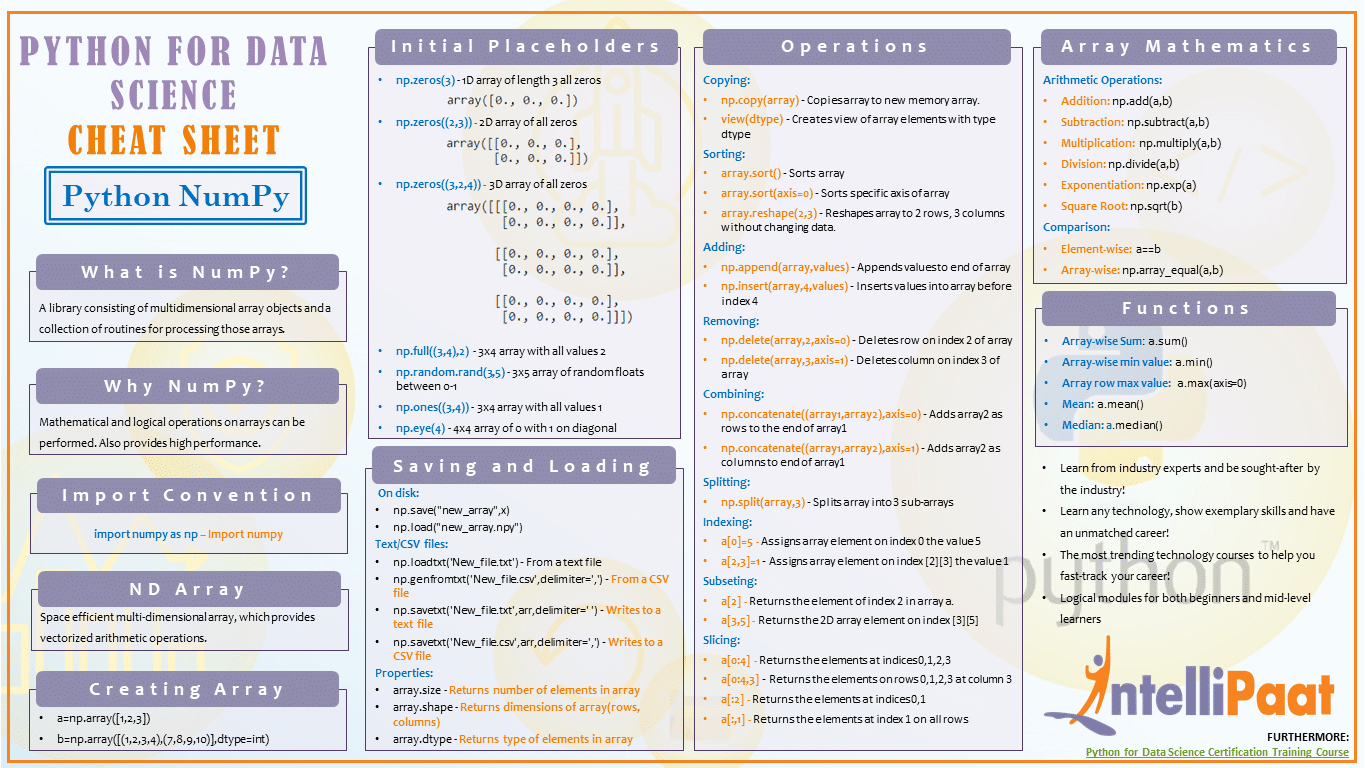NumPy Cheat Sheet: Data Analysis in Python This Python cheat sheet is a quick reference for NumPy beginners. Given the fact that it's one of the fundamental packages for scientific computing, NumPy is one of the packages that you must be able to use and know if you want to do data science with Python. This cheat sheet is the most concise Python cheat sheet in the world. It contains keywords, basic data structures, and complex data structures—all in a single 1-page PDF file. If you’re lazy, this cheat sheet is a must!
- Python cheatsheet
Operators¶
Command | Description |
|---|---|
| multiplication operation: |
| power operation: |
| matrix multiplication: returns |
Data Types¶
Command | Description |
|---|---|
| Constructs a list containing the objects (a1, a2,..., an). You can append to the list using |
| Constructs a tuple containing the objects (a1, a2,..., an). The (ith) element of (t) can be accessed using |
Built-In Functions¶
Command | Description |
|---|---|
|
returns |
| Make an iterator that aggregates elements from each of the iterables. returns |

Iterating¶
Command | Description |
|---|---|
| For loop used to perform a sequence of commands (denoted using tabs) for each element in an iterable object such as a list, tuple, or numpy array.An example code is prints |
Comparisons and Logical Operators¶
Python Data Analysis Cheat Sheet
Command | Description |
|---|---|
| Performs code if a condition is met (using tabs). For example squares (x) if (x) is (5), otherwise cubes it. |
User-Defined Functions¶
Command | Description |
|---|---|
| Used for create anonymous one line functions of the form: The code after the lambda but before variables specifies the parameters. The code after the colon tells python what object to return. |
| The def command is used to create functions of more than one line: The code immediately following |
Numpy¶
Command | Description |
|---|---|
|
|
| Access a the element in numpy array A in with index i1 in dimension 1, i2 in dimension 2, etc.Can use
returns the 2nd column (counting from 0) of A as a 1 dimensional array and
returns the 0th and 1st rows in a 2 dimensional array. |
| Constructs numpy array of shape shape. Here shape is an integer of sequence of integers. Such as 3, (1, 2), (2, 1), or (5, 5). Thus
Constructs an (5times 5) array while
will throw an error. |
| Same as |
| Returns a numpy array with (n) linearly spaced points between (a) and (b). For example
returns |
| Constructs the identity matrix of size (N). For example
returns the (3times 3) identity matrix: [begin{split}left(begin{matrix}1&0&00&1&0 0&0&1end{matrix}right)end{split}] |
|
returns If (a) is a 1 dimensional array then
returns [begin{split}left(begin{matrix}1&00&2end{matrix}right)end{split}] |
| Constructs a numpy array of shape |
| Same as |
| Reverses the dimensions of an array (transpose).For example,if (x = left(begin{matrix} 1& 23&4end{matrix}right)) then |
| Take a sequence of arrays and stack them horizontally to make a single array. For example returns returns (left( begin{matrix} 1&22&3 3&4 end{matrix}right)) |
| Like returns |
| By default
then
returns
returns |
| Same as |
| Performs similar function to np.amax except returns index of maximal element.By default gives index of flattened array, otherwise can use axis to specify dimension.From the example for np.amax returns returns |
| Same as |
| Returns an array equal to the dot product of (a) and (b).For this operation to work the innermost dimension of (a) must be equal to the outermost dimension of (b).If (a) is a ((3, 2)) array and (b) is a ((2)) array then |
numpy.linalg¶
Command | Description |
|---|---|
| For a 2-dimensional array (A). returns |
| Returns a 1-dimensional array with all the eigenvalues of $A$ as well as a 2-dimensional array with the eigenvectors as columns.For example,
returns the eigenvalues in |
| Constructs array (x) such that but numerically more stable. |
Pandas¶
Numpy Python Cheat Sheet
Command | Description |
|---|---|
pd.Series() | Constructs a Pandas Series Object from some specified data and/or index |
pd.DataFrame() | Constructs a Pandas DataFrame object from some specified data and/or index, column names etc. or alternatively, |
Plotting¶
Python Numpy Cheat Sheet Pdf
Command | Description |
|---|---|
| The plot command is included in plots the cosine function on the domain (0, 10) with a green line with circles at the points (x, v) |
